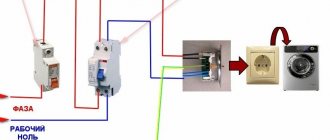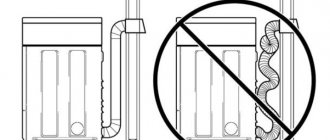We are looking for a heater in the housing
In washing machines from Beko, the tubular electric heater is located in a standard place for machines - under the tank.
Getting to the heating element is not difficult: just disconnect the equipment from the network and water supply, unfold the case, remove the back panel, remove the drive belt and take a closer look. Immediately below the bottom of the drum there will be the desired element - a round metal “die” with many connected wires. It is impossible to confuse the heating element with a motor or another element of the washing machine - it is always under the tank and surrounded by wiring. This is the first thing that catches your eye after disassembling the machine.
While it is not difficult to find and replace the heater, problems often arise in determining the cause of the breakdown. The heating element fails due to many problems, and before work it is recommended to carry out a comprehensive diagnostics of the device. As a rule, the following malfunctions lead to “thermal failures”:
- sudden power surges in the network;
- incorrect operation of the heating element temperature sensor;
- overheating of the device due to a thick layer of scale (if the water in the water supply is dirty or too hard);
- water getting on the contacts;
- human inattention or error;
- manufacturing defects.
In most cases, replacing a faulty heating element will eliminate the problem. It’s worse if the control board is “to blame.” A module that is not working correctly, for example, due to damaged “tracks” or loose contacts, must be repaired separately. However, it is strongly not recommended to repair the electronic unit yourself - it is safer to contact a service center.
General rules for repairing electrical equipment
We replace the heating element in the washing machine with our own hands. step by step
Let's reveal a secret: not a single production that produces washing machines creates the components for them. This is done by related enterprises. The consequence of this is an increased risk of supplying low-quality goods. More responsible manufacturers send their representatives to suppliers for control, while hacks simply try to purchase parts cheaper. This is the main cause of breakdowns. But there are others:
- The control sensor or spiral has burned out. This happens due to power surges in the network, when, for example, wires overlap on overhead electrical transmission lines.
- Poor water quality. Calcium significantly impairs heat transfer, which significantly reduces heating efficiency. Under the influence of high temperature, the substance hardens and begins to settle on the surface of the heater. Another negative factor is that calcium provokes an increase in the heating temperature of the nichrome spiral, since the latter are not suitable for such modes and quickly burn out.
What causes the crash
The first sign of a heater malfunction is washing in cold water (if you select a high temperature mode). The machine washes in cold water due to a breakdown of the water heating system as a whole.
If you, for example, have a SM Samsung Diamond, then error code H1 will appear on the display, and the wash will end early. The reasons may be:
- malfunction of the control unit;
- temperature sensor failure;
- heater failure.
Most often, the heating element fails due to poor water quality. If the water in the water supply system is too hard, when washing at high temperatures, and especially when boiling, scale forms on the heating element.
If you do not carry out periodic preventive maintenance and do not deal with water hardness and scale itself, the layer becomes thicker. Over time, the heat generated by the heating element stops passing through the thick coating, and the heater burns out.
You may not notice it right away, but when the clothes stop washing or the error code comes on, everything will become clear.
Prevention
Do not forget about preventive measures regarding the Indesit washing machine. Having replaced the old heating element with a new one, maintenance of the tank will be required in order to remove the dangerous deposits accumulated there. The tank may contain solid impurities in the form of scale. Sometimes undigested fats from things are deposited there (in the form of mucus). This fat gives off an unpleasant odor.
Preventive measures should be carried out periodically, depending on how often you run the wash and at what temperature conditions. So, to prevent the formation of deposits in Indesit machines, it is recommended to do the following.
- A special salt filter will need to be installed in the operating water supply gap. This must be a high-quality softener, which will always need to be replaced in a timely manner.
- For washing, it is recommended to use only high-quality powders and gel compositions - with their use, heating elements and other components of washing machines last much longer.
- Do not forget to carry out periodic preventative maintenance on your appliances against scale by using specialized products sold in many retail outlets. People often use folk remedies, such as vinegar or citric acid, which easily remove excess fat deposits and scale. But we must take into account that no one can say for sure how these chemical compositions can affect the condition of the rubber elements and seals of the machine.
- Do not overdo it with too frequent wash cycles using high temperature water. Detergents produced by modern manufacturers can effectively combat most contaminants at low temperatures. Thus, washing clothes is more gentle and gentle.
- You should always keep the condition of your household appliances under control. Of course, many users do not delve into possible problems and think about them only when they encounter them. It is advisable to check from time to time whether all components of the unit are working properly and whether there are any malfunctions.
See below for a master class on replacing the heating element.
Step-by-step instruction
Before removing the heating element from the washing machine, you need to remove the front or rear panel.
To remove it, you must:
- disconnect the SMA from the network;
- turn off the water supply and disconnect the hose;
- remove the powder dispenser tray;
- remove the clamp securing the loading hatch seal;
- push the rubber part inside the drum;
- disconnect the wires from the control panel and the sunroof latch drive;
- Unscrew the screws in the upper and lower parts of the panel;
- lift the part and pull it towards you from the hooks.
After this, it is possible to replace the heating element of the washing machine.
How to remove a heating element from a washing machine
The heating elements in the SMA are secured using a sealing gasket, which expands after it is tightened with a nut. To replace the TEN you need to do the following:
- Disconnect the power wires by removing the terminals from the heater terminals. If a temperature sensor is installed on the element flange, then it is necessary to disconnect it and remove the grounding conductor.
- Unscrew the nut located on the stud in the middle of the flange by 4-5 turns.
- Press the pin into the drum. This will loosen the seal assembly. You don't need to use a hammer for this.
- Remove the heater from the tank. If it was not possible to get the heating element, then you need to move it with rocking movements and then pull it towards you.
There is no need to make excessive efforts to dismantle the element, because The seat can be damaged, and this will lead to a leak. After removing the heating element, you can remove the temperature sensor. It has no fastening, and tightness is achieved by a tight fit in the sealing rubber.
How to check the performance of the heating element
Before replacing the heating element in the washing machine, you need to find out the reason for its breakdown. It is impossible to visually find a defect, because almost the entire surface of the tube is covered with scale. Therefore, the cause of the breakdown is determined using a multimeter. To do this you need:
- Move the mode switch to the resistance measurement position in the 200 Ohm range.
- Connect the probes of the device to the heater terminals. For a working element with a power of 2 kW, the conductor resistance is 20-30 Ohms. If the device shows 1, then the spiral has burned out. This is enough to reject the part.
In the case when the multimeter shows the presence of resistance close to normal, check the breakdown on the housing. For this you will need a megohmmeter, because... the tester will not be able to measure exactly this value. The heater insulation resistance value should be more than 500 mOhm. If the device showed the value Riz. 50-100 mOhm, then a leakage current may appear in the element in a hot state. This indicator is a rejection indicator, so the heating element should be changed.
Installing a new
Before installing a working element, it is necessary to carry out the above measurements. If the heater has the required characteristics, it can be installed in its original place. In the case when the heating element has a curved shape, it is positioned so that the main part is closer to the bottom of the tank.
To ensure a tight seal, it is recommended to apply sealant to the surface of the rubber seal. The element must be installed without distortion so that the flange completely covers the hole. The nut pressing the seal is tightened until the heater cannot be moved. After this, the flange should not be sealed further, because it can be squeezed out.
After installing the heating element, install the sensor and connect the wires. The performance of the element and the quality of the assembly are checked by operating the SMA in a mode that provides for heating the water. If everything is done correctly, the machine is assembled and installed in place.
Voltage drops
A sharp surge in voltage during the washing process can lead to the heater simply burning out, then in any case the owner will have a question about how to change the lg heater in the washing machine, and most importantly, can you do it yourself? The answer is obvious, without special skills and appropriate education, it is impossible, and besides, you will need a certain tool. Again we come to the conclusion that we cannot do without the help of qualified LG service specialists.
This outcome can be avoided; to do this, it is advisable to install a separate outlet for the machine, which will be powered from an individual differential machine.
How to change an Indesit top-loading washing machine?
For Indesit washing machines with vertical loading, the heating element is replaced through the front or side panel of the case.
Algorithm of actions:
- The machine is disconnected from the power supply, water supply and sewerage.
- The fixing bolts are unscrewed and the side panel is removed.
- There is a heating element located in the lower part of the housing under the tank; all wires are disconnected from it.
- The central nut is loosened with a socket wrench, the bolt is pressed in, and the heating element is pulled out.
- The new element is inserted into a seat cleared of debris and scale.
- The heating element is connected to the wiring.
- The side panel is returned to its original place and secured with bolts.
After repair, the washing machine is connected to communications, and a test wash is started.
And a little about secrets...
Have you ever experienced unbearable joint pain? And you know firsthand what it is:
- inability to move easily and comfortably;
- discomfort when going up and down stairs;
- unpleasant crunching, clicking not of your own accord;
- pain during or after exercise;
- inflammation in the joints and swelling;
- causeless and sometimes unbearable aching pain in the joints...
Now answer the question: are you satisfied with this? Can such pain be tolerated? How much money have you already wasted on ineffective treatment? That's right - it's time to end this! Do you agree? That is why we decided to publish an exclusive interview with Professor Dikul, in which he revealed the secrets of getting rid of joint pain, arthritis and arthrosis.
Attention, TODAY only!
Changing the heating element
In a Samsung machine, the heating element is located in front and to remove it, you will have to remove the front panel. Despite the fact that in front of the Samsung machine there is a detergent dispenser, a control panel and a hatch for loading laundry, replacing the heating element is not as difficult as it might seem at first glance.
This arrangement of the heater has a plus - you don’t have to unfold the unit and disconnect the washing machine from the water and sewer lines. Accordingly, there will be less dirt after such repairs.
The front panel is dismantled as follows:
- The water remaining in the tank must be drained, for which you need to remove the drain filter;
- The container for washing powder must be removed by pressing the small button located inside it;
- After removing the dispenser, you will have access to two fasteners that need to be removed;
- The screw located on the control panel is unscrewed;
- Without removing, the front panel should be moved to the side;
- Using a thin screwdriver, you need to pick up the clamp holding the sealing collar, turning it inside the drum;
- Unscrew the fasteners holding the small panel located near the debris filter. It is also convenient to pry off the panel with a screwdriver for ease of dismantling;
- Behind the panel you will find four fasteners that should be unscrewed;
- Lift the control panel slightly and place it on the top wall of the machine. There are three screws in place of the panel - they should be unscrewed. The main thing is not to break the wires going to the panel;
- Remove the front wall by lifting it up and removing it from the two hooks holding it. At the same time, you should not pull it too hard so that the hatch lock wires do not come off;
- The control panel now needs to be lowered down so that it does not interfere with the repair and does not fly off the cover.
Behind the removed front wall is the shank of the heating element located under the tank. Before replacing the heater, it is useful to make sure that the old element has actually burned out. For this purpose, a multimeter is used to measure the resistance on the problematic heater.
To remove a faulty heater:
- Using a wrench (socket wrench), you need to unscrew the central nut. It is located on the shank, in the middle of the contacts;
- The wires should be disconnected from the contacts, remembering their location;
- A faulty heater needs to be rocked by holding the contacts;
- Using your hand or a hammer, you should tap on the stud on which the nut is located, which has already been unscrewed, so that it is pressed inward;
- Use a small flat screwdriver to pry up the old heating element to move it out of place;
- Pull the heating element out of the grooves holding it.
Important: when changing a faulty part, the main thing is not to use too much force so as not to break off the contacts. Then it will be much more difficult to pull out the heating element
To install a new heating element:
- Check the functionality of the new heater. A multimeter is used for this. This will eliminate the possibility of installing a defective part;
- The rubber sealing collar must be lubricated with machine oil or special lubricant. It is recommended to use WD-40 lubricant;
- The new heating element should be inserted in the place where the old one stood;
- The temperature sensor, if it is decided not to change it, is also installed in its original place;
- The wires that were disconnected before dismantling the old heater must be connected to the new element.
Causes of heating element failure
Any household device, regardless of manufacturer, can fail. Manufacturing defects
. No one is safe from it. There is only one piece of advice - take the machine for warranty repair.
Scale formation
. Using low-quality water during the washing process leads to machine breakdown. This is the most common cause of heating element failure.
Due to poor thermal conductivity, the scale layer prevents the water from heating. The heating element of the heating element overheats and burns out
. Also, the presence of scale promotes the development of corrosion on the metal surface, which causes a short circuit. We will tell you further about how to replace the heating element in a washing machine.
After making sure that the heating element of the heating element is definitely faulty, it is necessary to replace it. Of course, you can contact a specialist, but this is a more expensive route. You can fix this problem yourself.
Where is the heater located in the washing machine?
For different types of washing machines, the heating element may be located in different places: in front or behind. To determine the location of the heating element, you can look at the diagram of the machine, which is in the instructions or find it on the Internet by the name of the brand and model. You can go the experimental route: unscrew the back panel of the machine and carefully inspect the mechanisms. The heating element itself is located under the tank and inside the tank, but its part with the terminals is visible from the outside. If it is not there, you need to remove the front panel. At the front, the heating element is also located below the tank. As a rule, the process of unscrewing/screwing panels is not difficult.
As a rule, in Indesit, Ariston, Kandy, Electrolux machines, the heater is located at the back. For BOSH, Samsung, LG washing machines, the heater is located behind the front cover.
What does it look like and work like?
The heating element of an automatic washing machine (WMA) is a curved smooth tube with a conductive wire running inside it. The internal part is made of alloys with high electrical resistance. Changing the current parameters allows you to adjust the heating intensity .
Between the body and the working element there is a layer of material with high thermal conductivity. Between the contacts of the heater there is a socket for a temperature sensor, which determines the water temperature.
Some LG car models are equipped with heating elements that do not have an additional hole. In this case, the temperature sensor is located directly inside the tank.
To fix the heater more tightly in the seat, it may have a sealing collar or collar . This must be taken into account when choosing a part. Instead of a heater without a thermostat, you can install a heating element with space for a sensor, but the hole will require a special plug.
Stopping the washing machine during a cycle
- Incorrect position of the program selector knob. You need to check whether the handle is set to pause in the rinse mode.
- There is no power supply. You need to use a tester to check the presence of supply voltage in the outlet. It may well be that the plugs on the power panel have burned out or the machine has turned off.
- Blockage. Clean the inlet and outlet hoses.
- The pump is clogged or broken. It is necessary to remove the pump and check the rotation of the impeller. If the need arises, change the pump.
- The inlet valve is faulty or clogged. You need to clean it and, if necessary, replace it with a new one.
- Siphoning through the outlet hose. At the same time, water fills into the machine and it cannot carry out the set program. You need to check the quality of the connection between the riser and the outlet hose.
- Thermal relay failure. Let's check its work.
- Damage to the heating element. It is necessary to ring the electrical circuit of the heating element.
- Timer fault. The timer is included in the programmer. It is located at the front of the machine and is controlled using a control knob or special buttons. The device is too difficult to repair; it is easier to install a new one.
- Electric motor failure. To quickly check it you need to:
- remove the drive belt;
- set the program switch to “spin” and close the outer panels;
- plug the plug into the socket and check if the motor rotates;
- if not, you will have to disassemble the electric motor and check it.
How to replace a heating element using the example of the Bosch brand
It should be noted that you can remove the heating element from a Samsung washing machine by following these instructions. Since many Samsung washing machines have a heating element located in a similar way.
The work order will be as follows:
- First of all, you need to turn off the power to the washing machine;
- To get to the heating element, you need to remove the front panel. The first step is to remove the top panel, to do this you need to unscrew several hex screws. To speed up the process, you can use an electric screwdriver;
- The next step is to remove the detergent dispenser. This can be done by pressing a special latch lock;
- Next you need to remove the front wall. To do this, you will have to unscrew several screws; this will allow you to remove the control panel, which can be removed upward without disconnecting the wires. Then you need to remove the bottom panel. Then you need to disconnect the cuff on the hatch; it is secured with a spring clamp. They vary depending on the version, but for all models you need to pull it. After which the cuff moves inward, and all the screws holding the front wall and blocking the door are unscrewed;
- The heating element is located at the bottom of the tank. You need to disconnect all the wires that connect the heating element. To remember how they are connected, you can take a photo on your phone, this will help you connect them back correctly when reassembling;
- The heating element nut must be unscrewed. You should not unscrew it all the way, this will allow you to remove the heating element by pressing on the gasket;
- The next step after removing the heating element is to remove the thermostat. It can be installed in a new heating element. You can apply a few drops of dishwashing detergent to the seal, this will simplify the process of installing the part;
- To ensure that the new heating element fits into place correctly, you need to press it hard enough. It is secured by tightening the nut. If the seal is well secured, you can start connecting the wires;
- The final step is to install all the parts in the reverse order.
Replacing the heating element located at the rear of the drum
For many washing machines of the LG, Ariston, Indesit and Atlant brands, the heating element can be replaced through the back panel. Let's look at how you can remove the heating element from an Ariston washing machine.
In this case, the process of removing and installing a new heating element is much simpler. There is no need to remove the front wall and control panel. To remove the back cover you need to unscrew several bolts.
As in the case described above, it is best to first photograph the location of the wires. After this, you need to disconnect the wires and loosen the nut. There is no need to unscrew it completely, it should remain on the thread. Next, the pin is pressed in to remove the heating element.
Before finally assembling the washing machine, you should check whether all parts are installed tightly. To do this, you can pour water into the drum without starting the wash. If water leaks, you need to tighten the nut more tightly. And only after that complete the assembly of all parts.
In this case, the new heating element must be a complete analogue of the old one. And to simplify the process of changing a failed heating element, it is best to remove the drive belt.
For installation, it is best to purchase a new heating element; a used one will last much less, and then it will need to be replaced again.
If the heating element (heater) in your Samsung washing machine is broken, then you can determine this by the remaining dirty laundry. The machine simply cannot wash things in cold water.
You can also determine this failure yourself by the HE or TE error on the control module.
This error may indicate a malfunction of either the heating element itself or the water temperature sensor (thermistor). In this case, the wash program will be stopped because the water is not heated to the required temperature.
Removing the shade
Now you know how to remove the heater from the LG washing machine, all that remains is to loosen the central nut of the part and push the bolt holding the heater inside, after which you can start removing it. The sealing rubber bands are extremely reliable, so removing the part will not be so easy, the main thing is to do everything as carefully as possible, in order to avoid damage to the equipment itself. Once everything is ready, you can begin installing a new tena.
Similar articles:
- What do the icons on a washing machine mean: what symbols are on different brands of machines, photos
- Error codes for Asko washing machines (Asko) - how to fix them
- 7 best cordless lawn mowers - Rating 2020
- TOP 15 best glass-ceramic stoves: 2022 rating in price/quality ratio and choose
Where is the heating element located?
The tubular type heater or heating element in Samsung washing machines is usually located on the flange. The fuse is also located on it. In the event of a breakdown, you can do without contacting a service center if you know how to change the heating element on a Samsung washing machine yourself.
How to check a heating element with a multimeter
To check the heating element you need to know two parameters
- Resistance between contacts 20-40 Ohm (based on power)
- Resistance to housing is at least 20 megohms
If to check the first parameter (resistance between contacts) ANY multimeter or tester capable of measuring resistance within 100 ohms is suitable, then to check the second parameter (resistance to the body) you need a professional device, since a DT830 multimeter (DT832, DT839, etc.) d.) worth up to 1000 rubles. it is impossible to measure resistance within 20-40 Megohm. It is impossible to check the heating element with a cheap multimeter. A working heating element of a washing machine shows a resistance between the contacts of about 30 ohms, depending on the power, the more powerful the heating element, the lower the resistance will be and vice versa. The resistance to the body should be at least 20 megaohms, while in In rare cases, a seemingly serviceable heating element shows this parameter, but when water is added and during operation it begins to break through, i.e. currents are generated that go to the housing, which can knock out an RCD or DIF circuit breaker
How to remove and install heating elements
1. Unscrew the back wall in the Indesit washing machine (Indesit) in our example, or the front wall for LG (Elgie) and Samsung (Samsung) washing machines to access the heating element (TEN) in order to check it and replace it if necessary
2. Unplug the washing machine from the outlet and disconnect the wires before checking with a multimeter, check according to the instructions (see above) and unscrew the nut securing the pressure plate, but not completely, move the rod inside the tank
3. Using two screwdrivers and the lever principle, we remove the old heating element, trying not to damage the tank platform to which the pressure plate is adjacent, since when installing a new heater, water may leak
4. Install a new heating element selected according to the instructions and tighten the nut, install the wires, but do not screw the back wall, start the washing cycle and check the connection between the heating element and the tank for leaks
How much do the services of a master cost, where can I find one?
The cost of repairing or replacing the heating element in the service ranges from 1800 rubles. excluding the price of a new spare part . If the problem lies in the temperature or drying sensors, then replacing them will cost about 1,700 rubles. In case of malfunctions of the electronic unit or the heater control system, the cost of repair starts from 2,600 rubles.
When contacting a private master, you can reduce costs by 10-25%. If the washing machine is under warranty, then you should only contact the official service center of the brand.
To select a service provider, you can turn to directory sites and trading platforms. To minimize the likelihood of fraud, you must:
- Find reviews of companies on city forums, and when reading, pay attention to the spread of response dates.
- Call the most popular and reliable services, compare the cost of diagnostics and replacement parts.
- Find out the legal addresses of companies and check the presence of a branch at the specified coordinates.
Before starting repairs, you need to discuss the estimate with the technician and follow the diagnostic procedure. Reliable home appliance repair companies provide a receipt, a certificate of completion and a guarantee for the services. Depending on the type of malfunction, the warranty period ranges from 6 months to 2 years.
Replacing the heating element in a washing machine
We discussed why a heating element is needed in a washing machine, and why we cannot get rid of it yet. We have a regular boiler inside the device, which brings the temperature to the set temperature. To be fair, let’s say that there is not always a regular spiral, which is often shown in Calgon advertisements. There are also washing machines equipped with instantaneous water heaters. This allows you to complete the cycle much faster, but is accompanied by some technical difficulties in implementing the idea itself.
To be fair, let’s say that washing machines, unlike dishwashers, most often have heating elements. That is, tubular electric heaters that have nothing to do with induction, but are made in the form of traditional spirals of various shapes. However, there is one caveat:
The heating element of a washing machine for water is usually located at the bottom of the tank, somewhere under the drum (maybe a little on the side). At the same time, the heating element for air is usually located in the upper part of the housing in the area of the air duct. Any of them may require replacement. The typical price of a heating element for a water washing machine is about 1000 rubles. Of course, the cost of the issue largely depends on the brand of the device. It is also worth mentioning that in old washing machines there was an induction water heater that worked like a transformer, the secondary winding of which was a coil of aluminum wound (on an insulator) around a steel tube. Foucault's currents quickly heated the iron, and from it, the water.
And here are the first instructions! First of all, you need to look at what type of heating element the washing machine has. The easiest way to do this is to disassemble the case. In this case, the heating element is removed from the tank; there will probably be inscriptions on it that will tell you what kind of model it is. The second thing we do is check to see if there is any protection on the heating element. These are usually some kind of tubular structures that are not spiral and reinforced with steel clamps. There are at least three types of heating element protection:
- Bimetallic. This triggers the microswitch, which is located outside the heating element and is visible to the eye. The causes of the malfunction are usually the following: scale deposits or switching on with an empty tank. In any case, the carbon deposits are removed and the microswitch returns to its original state. There is some chance that the heating element of the washing machine is operational again.
- The solder protection releases, due to melting, a ceramic rod on a spring, which opens the relay inside the heating element housing. The device will have to be disassembled and the rod shortened. In the future, protection against overheating is no longer guaranteed.
- In the simplest case, there is a regular thermal fuse inside the tube attached to the heating element of the washing machine. It needs to be replaced.
The repair is quite simple. Don't forget to stock up on waterproof sealant, one that is not afraid of heat and will not cause allergic reactions. We have already raised this topic, but you can’t keep everything in your head. It is allowed to use Poxipol for the washing machine, which is NOT intended for food containers. During washing, a large amount of harmful substances will not be released. It's another matter if there is a turbo dryer. Here the dose of formaldehyde in the air is guaranteed, and it is better not to use Poxipol.
Please note that we have not yet told you how to change the TEN yourself. There is no such concept in nature. Also, do not try to buy a heating element for a washing machine in an online store.
Good luck!
Also, do not try to buy a heating element for your washing machine in an online store. Good luck!
If suddenly such a nuisance happened that your washing machine stopped heating the water, then most likely the heating element has failed.
You will learn how to replace the heating element of a washing machine yourself in this article.
Description and principle of operation of the heating element
The heating element is an electric heater responsible for heating cold water supplied from the central water supply system to the washing machine.
Structurally, it consists of a W- or V-shaped tubular part, inside of which there is a conductor element with a high level of resistance that can withstand heating to record high operating temperatures.
A multimeter will help you carry out a correct check of the heating element. Using this measuring device, you can “ring” (test) the heating element at home and determine whether it is working or not.
The heating coil is surrounded by a special dielectric insulator with a high thermal conductivity. It correctly absorbs the heat emanating from the heating element and transfers it to the steel outer shell.
The working spiral itself is soldered with its outgoing ends to the contacts, which receive power during operation. Nearby there is a thermal unit that measures the level of water heating in the washing tank.
When activated through the control unit of any of the processing modes, a command signal is sent to the heating element.
The element begins to warm up intensively and, releasing the generated heat, brings the temperature of the water in the washing drum to the required temperature specified by the user.
Progressive models have a special hole in their design for a temperature sensor (in the figure the arrow points to it). It vigilantly monitors the level of water heating in the drum and promptly turns off the working element, allowing you to rationally and economically consume electrical energy
As soon as the water reaches the required temperature, the sensor records this and transfers the data to the control unit. The system reacts to the information received and automatically turns off the device, stopping water heating.
How to remove it from the washing machine?
To remove the heating element, you will need the following set of tools:
- crosshead screwdriver;
- flat screwdriver;
- wrench 8;
- lubricant - it will come in handy if the bolts are very rusty, the best option is VD-40;
- multimeter
You should not delay repairing the heating element. A faulty part very often leads to damage to the control board. At the same time, the electronic module costs 3 times more than an electric heater.
To remove the heating element, proceed as follows:
- Disconnect the device from the network.
- Drain the remaining water in the drum. You can use an emergency hose to do this.
- Turn off the water supply tap.
- Disconnect the inlet hose. The drain hose is removed from the sewer drain.
- Unscrew the bolts holding the back wall, remove it and set it aside.
- They find a heating element. If inspecting the part is problematic because of the belt, it must be removed.
- Assess the tightness of the contacts to the terminals of the heating element. If one of them has come off, it must be returned to its place, and then the functionality of the equipment must be checked. If there is no heating, the process of removing the part continues.
- Unscrew the main nut, which is located in the center. Remove the temperature sensor.
- Press the bolt inward to depressurize the seal.
- Using light rocking, remove the heating element from the socket.
When removing the heating element from its seat, you must act carefully so as not to damage it. If force is applied to a burnt-out area, the tube may break off
Getting the rest of it will be problematic.
What will be needed for replacement?
So, having purchased the necessary part for repairing washing equipment, prepare the tools for its installation. You will need:
- Two screwdrivers - flat and Phillips;
- Spray lubricant to loosen boiled joints (eg WD-40);
- Multimeter;
- Keys and socket heads of the required sizes to remove the back cover (in most cases, a “figure eight” will do).
Changing the heater
Replacing the heating element of a washing machine of this brand will initially require removing the top cover of the washing machine, otherwise it will be impossible to remove the back wall. There should be no problems with pulling off the top cover, but if difficulties still arise, read the appropriate instructions posted on our website.
Next, you need to get rid of the screws that hold the back wall, and then easily remove it. Now you need to take a phone and photograph the position of the wires on the contacts of the heating element, so that you don’t confuse anything later, otherwise you can easily burn the new part, and at the same time the control board. The next step is to remove the wires from the contacts of the heating element, as well as the thermistor.
We check the heating element with a multimeter. If you have problems with this, read the article called Checking the heating element of the washing machine. It describes the features of the test very well. Next we do the following.
- We find a bolt with a nut in the center between the contacts of the heating element, put the head on the nut and unscrew it.
- Using the handle of the ratchet, apply a light blow to the bolt so that it falls slightly.
- Using a flat-faced screwdriver, carefully pry off the heating element, or rather its rubber seal.
- After this, we pull the heating element by the contacts carefully, but firmly, until it comes out. It is advisable to remove it without breaking off the contacts.
- We inspect the old heating element and put it aside.
- Use your fingers to remove debris and dirt from the bottom of the tank, and then wipe the seat under the heating element with a rag.
- We take a new heating element, lubricate its rubber, and then insert the part into place.
- We make sure that the part fits tightly, tighten the nut and put on the wires, then assemble and connect the washing machine.
At this point we can assume that the replacement of the burnt part was successful. As you can see, this is a simple repair that is theoretically accessible even to an amateur. However, when repairing an LG washing machine, remember safety precautions. Before performing any manipulations, turn off the water and power supply - be careful, good luck!
Part location
First you need to find out where the heating element is located in the LG washing machine. In machines of this brand, the heating element is located below the tank, access to it is through the rear wall of the housing. Therefore, you just need to disconnect the machine from communications and turn its back cover towards you. Once the LG washing machine has its back wall facing you, all that remains is to remove this wall and you will immediately gain access to the element you are looking for.
In this case, the drive belt won’t even bother us, since most LG washing machines have direct drive, which means there is no trace of any drive belt. to confuse the heating element of an LG washing machine with any other part. Although most of this part is recessed into the depths of the washing tub, two contacts stick out, to which many wires go. And these contacts are located exactly in the center of the bottom of the tank - open the back wall of the washing machine, and they will be under your nose.
In this case, finding a heating element for a washing machine of this brand is not a problem; difficulties may arise when dismantling and installing it.
What is needed for repair?
The beauty is that replacing the heating element in washing machines of this type will not require a significant number of tools, and you will only need a new, working heating element as materials. Here the first question arises: how to buy a new heating element so that it is good, fits perfectly and is inexpensive?
First you need to inspect the old part for inscriptions and symbols. If you were able to see some letters and numbers, write them down on a piece of paper, or better yet, take the old heating element and go straight to the washing machine spare parts store with it. If this is not possible and the markings on the old heating element are not visible, then at least determine its power. Usually the power of the heating element of an LG washing machine is 1900 or 1950 W, but sometimes you come across machines with 2000 W heating elements.
You can purchase a new spare part for a washing machine not only in your hometown or village. A good heating element can be ordered from an online store. Just please do not visit dubious sites, choose only top online stores with a good reputation. The average cost of a new heating element is $10.
Typically, online stores of spare parts for washing machines are at the top of the search engine results.
Now about the tools. There is not much to say here, since all you need is:
- crosshead screwdriver;
- flat screwdriver;
- any lubricant;
- multimeter;
- 8 socket and ratchet.











